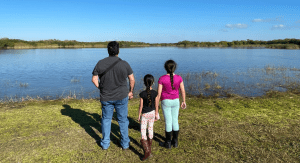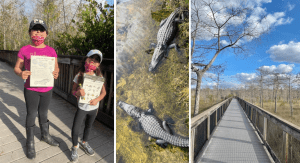
Everglades National Park is a peaceful and majestic family-friendly place where you can discover so many wild and wonderful natural splendors. As the only subtropical preserve in North America, it’s an integral part of the largest wetlands ecosystem in the country. There are so many treasures to discover here, including unique animals, plants, and birds.
Due to the ongoing pandemic, we’ve been spending less time around other humans and more time enjoying the great outdoors. We recently set out to explore this incredible national park. Truth be told, I had never set foot in the actual park that’s located in Homestead — even though I’ve lived in South Florida twenty-something years and it’s right in our backyard. I can’t believe what I’ve been missing out on all these years!
The Everglades is unique because of its intricately balanced environments where all sorts of animals and plants thrive. Some of the most iconic parts of the Everglades include hardwood hammocks, cypress swamps, mangrove forests, rocky pinelands, sawgrass marshes, and prairies. You’ll also find sloughs, free-flowing channels of water that remain flooded for most of the year. Turtles, snakes, and fish are found in these waters, as well as many water lilies.
Of course, the Everglades is home to countless alligators. They love to hang out in swamps and marshes and can range up to about 15 feet in length. It’s also home to the elusive Florida panther, the West Indian manatee, black bears, Key deer, and hundreds of indigenous birds and reptiles.

Popular Trails
Upon entering the park in Homestead, our first stop was the Anhinga Trail — one of our favorites. Here we spotted lots of birds (mostly anhingas, of course) and our first alligator. This self-guided trail is just under a mile long and winds through a scenic sawgrass marsh that’s totally Instagrammable. Right next to it is the Gumbo Limbo Trail, which is less than half a mile long. This jungle-like trail meanders through gumbo limbo trees, as well as air plants, royal palms, and more.
Down the road is Pinelands Trail, another short trail that’s filled with pine trees, palmettos, and wildflowers. Watch your step because there are solution holes on the sides of the trail, which are formed when decaying plant life eats through the limestone. Next up is Pahayokee Overlook, where you walk up a boardwalk that takes you to an observation deck for some spectacular views. The Mahogany Hammock Trail is a half-mile long walk that meanders through lush vegetation. The highlight here is catching a glimpse of the largest living mahogany tree in the United States.
All of these trails are part of what is referred to as the Pine Island Trails and they can be easily done in one day.
You can also venture over to the far end of the park and explore some of the Flamingo Trails, such as Snake Bight, a longer, wilder trail with tropical trees and lots of birdwatching opportunities. We haven’t experienced all the Flamingo Trails yet, but we hope to explore more soon.
Then there’s also the Shark Valley Trails, including Bobcat Boardwalk, which is a mile-long round trip, and the Otter Cave Hammock Trail — a short but rough limestone trail through the forest that can sometimes get flooded.

Big Cypress National Preserve
This past weekend, we decided to explore yet another area. Big Cypress National Preserve is a federally protected wilderness that is essential to maintaining the Everglades’ ecosystem. It’s a haven for wildlife, including herons, bald eagles, white-tailed deer, bobcats, and, of course, alligators. We stopped at the Oasis Visitor Center, where we obtained the Junior Ranger booklet for my girls to fill out, strolled the boardwalk, and spotted several alligators right there. Then we continued on our long, leisurely drive, looking for wildlife along the way. We saw more alligators on this day than I have ever seen before! I think we lost count at around 30.
In addition to the scenic drives at Big Cypress, you can also enjoy some nice trails. One of our favorites was the trail at Kirby Storter Roadside Park, where a boardwalk takes you through a sawgrass prairie and into a cypress swamp. Along the way, we spotted herons, egrets, and turtles. My girls enjoyed doing the Junior Ranger scavenger hunt and looking for various wildlife and plants. Once you complete the activities in the booklet, you can earn a badge. If you complete the entire booklet, which covers Big Cypress, Everglades National Park, and Biscayne National Park, you earn three badges plus a South Florida’s National Parks patch.
We ended the day by driving into Everglades City, a quaint Old Florida town, and having an outdoor dinner at one of the local establishments. The girls and I ordered grouper and my husband had fried gator.
Book a Tour
The best way to get around the wet and wild Everglades is to take an airboat tour through the sawgrass on one of these iconic vessels. If you haven’t experienced this yet, I highly recommend it!
If you’re a fan of feathered friends, grab your camera and binoculars and head out on a guided tour to look for storks, cranes, eagles, and more. Hundreds of bird species have been identified in this part of Florida.
There are also canoe trails in the park where you can join a group, launch your canoe or kayak and paddle your way across the sawgrass, catching a glimpse of the beautiful mangroves and wildlife.
If you stay into the night, stargazing is quite popular in these parts, because it’s far away from the lights found in local communities. There are stargazing events and ranger-led programs for viewing the starry night skies in the natural darkness.
Every Kid Outdoors
Did you know that fourth graders can get a free pass to see America’s parks and historic sites? Just log onto everykidoutdoors.gov, follow the instructions to get your pass, and then plan your trip. It’s super easy! We got the pass for our fourth grader and it admits all of us to the national parks and federal lands for free. We were super excited to learn about this program and, as you can see, we’re already putting it to use.
Whether you set out on your own or book a tour, it’s a good idea to bring snacks, plenty of water, bug spray, sunscreen, a hat, binoculars, and a camera. No matter which part of the Everglades you explore, there’s no doubt you’ll have an unforgettable experience.















I’ve wanted to go to the Everglades but didn’t know where to begin. This is great! Thanks for sharing.
Comments are closed.